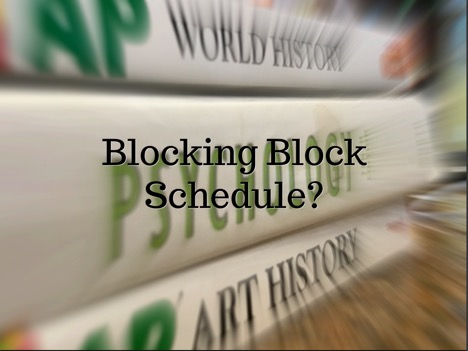Breaking Block Schedule?

April 28, 2018
On a normal day at Quartz Hill High School, the bell schedule consists of six classes, snack, and lunch. The six classes are broken up into six periods, and a typical student would spend about sixty minutes per class, ten minutes for snack, and thirty-five minutes for lunch. This schedule was changed for the weeks of April 2nd and April 16th, and students had to follow a block schedule so that juniors and seniors could conduct standardized testing.
Block scheduling consists of three periods, snack, and lunch. These three periods are on average two hours long. Snack and lunch remain the same.
While the majority of students at QHHS are no stranger to this schedule, having experienced it in middle school, the change in the timetable has certainly left students and teachers alike in a field of mixed emotions.
QHHS student Desiree Nolls said, “I personally did not like block scheduling. I felt that it made the periods more drawn out. I think by making the classes much longer it made students’ and teachers’ behaviors too relaxed.”
Teachers also expressed their opinions. World History and AP Human Geography teacher Mrs. Bertell said, “I really don’t like block schedule. By the second hour, kids are already getting tired, and most of the lesson the teacher teaches doesn’t get absorbed.”
Some students expressed positive opinions toward block schedule. Youmna Ebrahem said, “I like it. It’s like my old school, and there’s a day in between to catch up on homework. The load is light, which means more free time to do other things. Kids are just complaining because they have to sit in a classroom with the same people for two hours, but it really isn’t that bad. Most of the time, the teachers just give you work to do, and you have the entire period to do it. If you finish off your work while being productive, congratulations, you’ve finished your homework.”
Although students varied in opinions, most teachers agreed that the scheduling did not work in their favor and that students tired out easily. Many noticed students falling asleep by the second hour out of pure exhaustion. Students also got nervous and jumpy after being forced to sit down in one place for two hours. Oftentimes, the atmosphere in the classroom would go from rigid and controlled to loose and hard to control due to the amount of time spent in one classroom.
But, does the block schedule benefit or negatively impact students? Having three classes a day means less homework, and an extra day to catch up on homework if necessary. This allows for more free time for students to do activities after school. At the same time, students begin to get tired after the first two-hour block, and their energy drains constantly throughout the day. Some teachers have to scramble to find something to teach for two hours, while others have plenty of material, but tired students. Although students have an extra day to do homework, teachers feel as though they have lost a day. Due to the added amount of fatigue and complaints from both teachers and students, it’s clear that a block schedule isn’t widely welcomed around QHHS.
